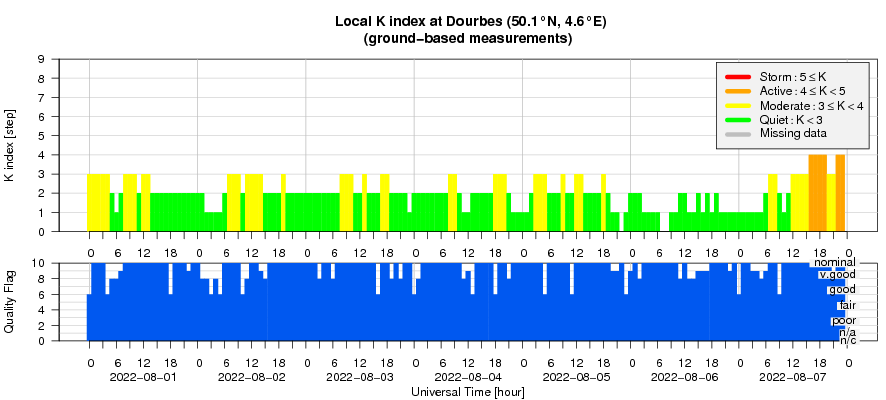- Table of Content
- 1.An outstanding...
- 2.Review of sola...
- 3.Review of geom...
- 4.PROBA2 Observa...
- 5.The Internatio...
- 6.Geomagnetic Ob...
- 7.The SIDC
- 8.Action!
2. Review of solar activity
3. Review of geomagnetic activity
4. PROBA2 Observations (1 Aug 2022 - 7 Aug 2022)
5. The International Sunspot Number by SILSO
6. Geomagnetic Observations at Dourbes (1 Aug 2022 - 7 Aug 2022)
7. The SIDC
8. Action!
An outstanding prominence
Solar prominences are clouds of charged particles ("plasma") above the solar surface squeezed between magnetic regions of opposite polarity. Being cooler and denser than the plasma underneath and their surroundings, they appear as bright blobs when seen near the solar limb and as dark lines when seen on the solar disk (then they are called "filaments"). These features are not visible in white light, and require special filters such as the Hydrogen-alpha (H-alpha) line in the red part of the solar spectrum at 656.3nm, which shows the lower atmosphere of the Sun at temperatures between 6.000 and 20.000 degrees. They are also visible in extreme ultraviolet (EUV) at passbands near 30.4 nm showing the Sun near 80.000 degrees. In EUV filters showing the Sun at even higher temperatures, e.g. 19.5 nm filter for temperatures near 1.25 million degrees, the most dense and coolest portions of the prominence become visible as dark strands moving against the bright background of the solar atmosphere.
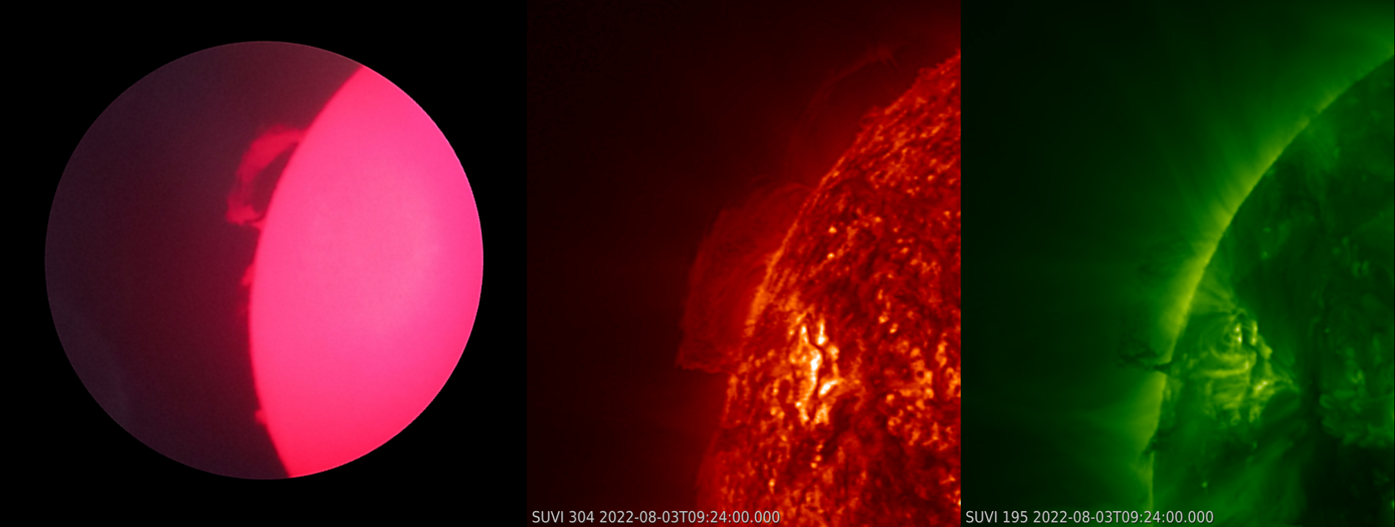
The images above show a prominence rotating over the northeast solar limb on 3 August around 09:20UTC. The picture to the left is as seen through a small H-alpha telescope, whereas the other two (slightly zoomed and correctly oriented) images are in EUV taken by SUVI (Solar UltraViolet Imager) on board the GOES-16 (https://www.swpc.noaa.gov/products/goes-solar-ultraviolet-imager-suvi ). The reddish image is the prominence as seen at 30.4 nm, the greenish image is the same feature as seen with a 19.5 nm filter. Notice the dark prominence strands in the latter. The apparent height of this quite dynamical prominence was about 80.000 km in H-alpha and SUVI 195, and about 96.000 km in SUVI 304.
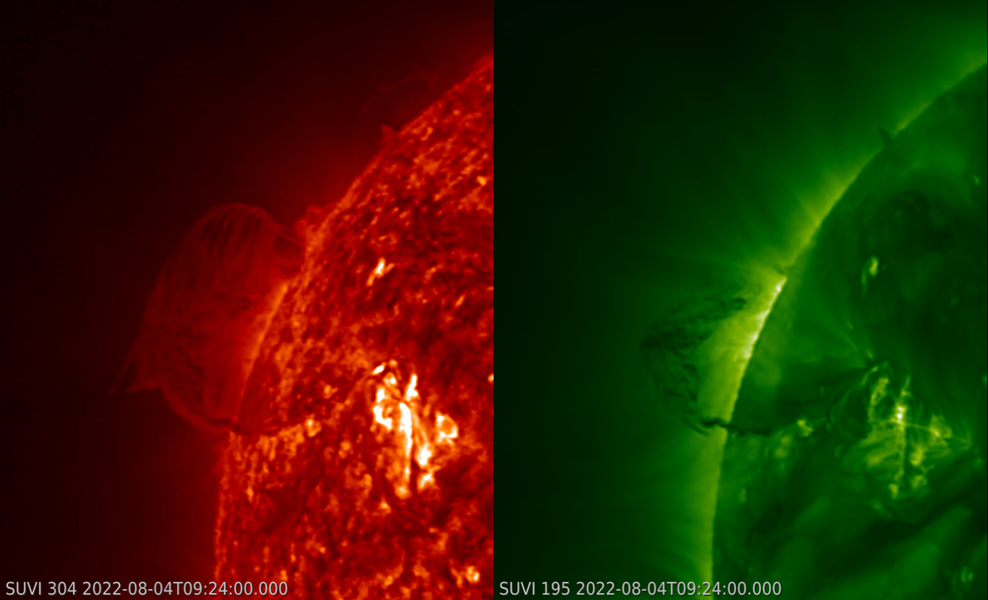
The next day, the prominence's height had risen to resp. 116.000 km and 135.000 km (see the SUVI imagery above - movies are available in the online version of this article at https://www.stce.be/news/601/welcome.html ). A portion that had already rotated over the limb was visible as a filament. The prominence was now becoming unstable and dissolved during the remainder of the day and the next day (5 August). Most of the material remained trapped in the solar magnetic fields and rained down to the solar surface. No large coronal mass ejection (CME) seems to have been associated with this prominence "eruption". The wide CME that can be seen in coronagraphic images (SOHO/LASCO C2 - https://soho.nascom.nasa.gov/ - image underneath) later on 6 August is thought, based on STEREO-A coronagraphic imagery, to originate from the Sun's far side.
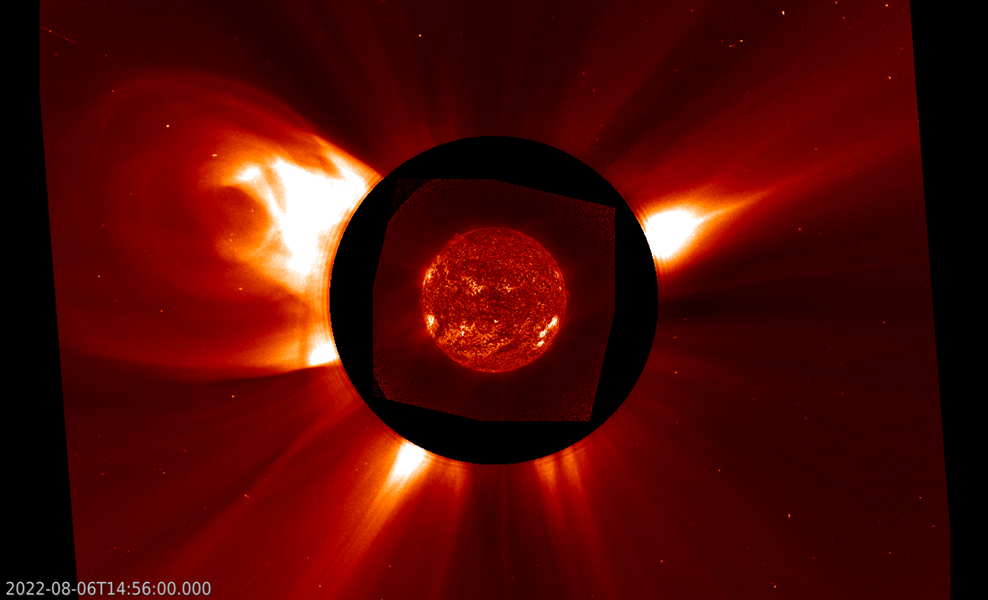
Movies and images were created with the Space Weather Helioviewer (SWHV - http://swhv.oma.be/user_manual/ ).
Review of solar activity
Low Flaring activity
Solar activity was at very low to low level with 11 C-class flares and no M- or higher class flares. There were in total ten active regions on the visible solar disc, namely NOAA 6062 and NOAA 6068 - NOAA 3076, the majority of which were simple and inactive. The strongest registered activity throughout the week was a C9.3-class flare from behind the north-east limb with peak time 23:09 UTC on July 31st. NOAA AR 3068 was the largest and most complex active region reaching magnetic type beta-gamma. Regardless of its complexity, this sunspot group produced only a few low C-class flares.
No Earth-directed Coronal Mass Ejections
Multiple filament and a prominence eruptions were observed and three type II radio bursts were detected. None of these events resulted in an Earth-directed coronal mass ejection (CME).
No elevated solar particle flux
The greater than 10 MeV proton flux was at nominal level and the greater than 2 MeV electron flux only briefly crossed the 1000 pfu threshold in the UTC afternoon of July 31st and remained well under the threshold for the rest of the week.
The electron fluence was at nominal level.
Review of geomagnetic activity
The week started with slightly elevated solar wind velocity under the mild influence of a high speed stream (HSS) from a negative polarity coronal hole. These enhancements continued throughout Aug 4th with maximum solar wind speed up to 560 km/s. The solar wind conditions returned to background levels on Aug 5th and Aug 6th until the arrival of another HSS from a positive polarity coronal hole in combination of a sector boundary crossing around midnight UT on Aug 7th. The magnitude of the interplanetary magnetic field reached 15 nT with a minimum recorded Bz component of -13 nT in the afternoon of Aug 7th while the solar wind speed remained below 450 km/s by the end of the forecasting week.
The geomagnetic conditions were mostly quiet to unsettled. Some active periods were observed in the beginning and towards the end of the forecasting week due to the two high speed stream arrivals.
PROBA2 Observations (1 Aug 2022 - 7 Aug 2022)
Solar Activity
Solar flare activity fluctuated from very low to low during the week.
In order to view the activity of this week in more detail, we suggest to go to the following website from which all the daily (normal and difference) movies can be accessed: https://proba2.oma.be/ssa
This page also lists the recorded flaring events.
A weekly overview movie (SWAP week 645) can be found here: http://proba2.oma.be/swap/data/mpg/movies/weekly_movies/weekly_movie_2022_08_01.mp4.
Details about some of this week's events can be found further below.
If any of the linked movies are unavailable they can be found in the P2SC movie repository here: https://proba2.oma.be/swap/data/mpg/movies/.
Wednesday Aug 03

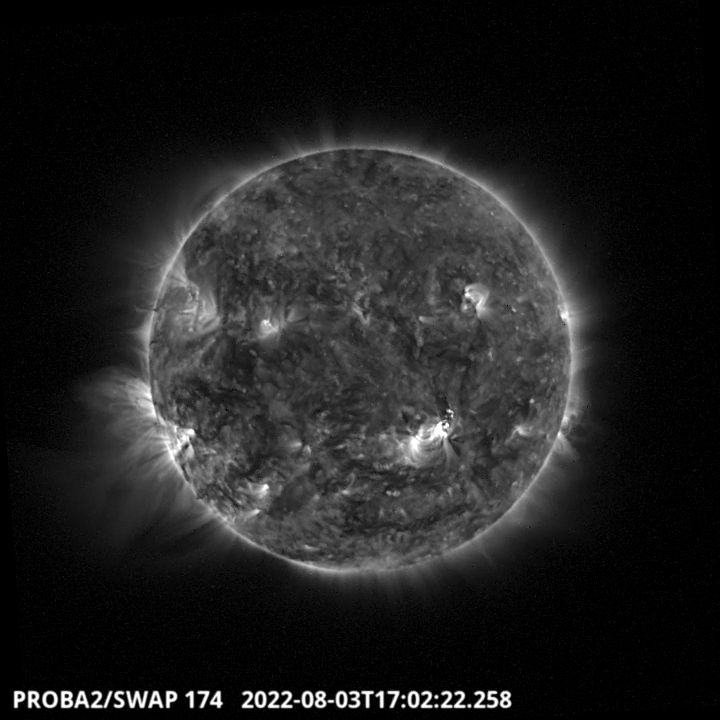
The largest flare of the week, a C6.9 flare, was observed by SWAP and LYRA. The flare was associated with NOAA AR3068 located at S12W22 on 2022-Aug-03, as shown in the SWAP image above taken at 17:02 UT.
Find a SWAP movie of the event here: https://proba2.sidc.be/swap/movies/20220803_swap_movie.mp4.
Saturday Aug 06
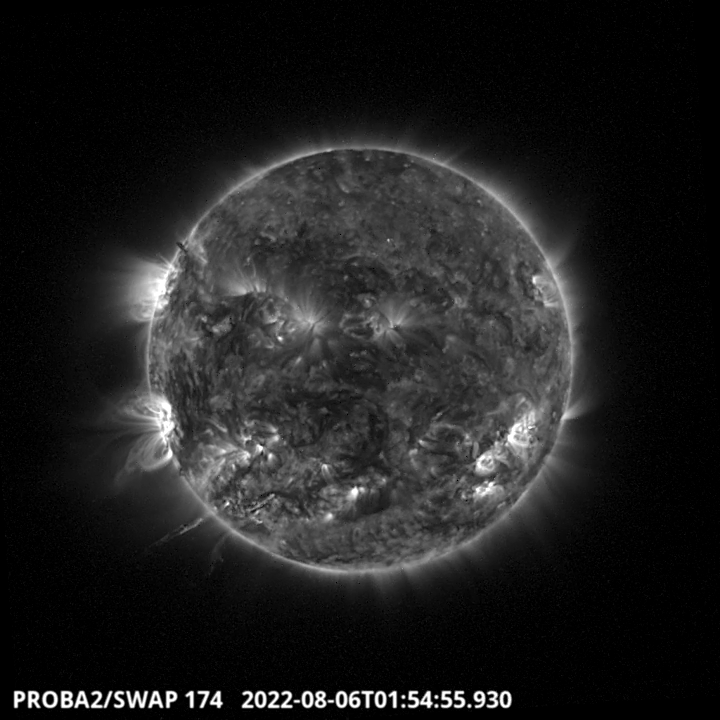
A filament eruption occurred around 01:30 UT on the South-East quadrant, close to the solar limb.
Find a SWAP movie of the event here: https://proba2.oma.be/swap/data/mpg/movies/20220806_swap_movie.mp4.
The International Sunspot Number by SILSO
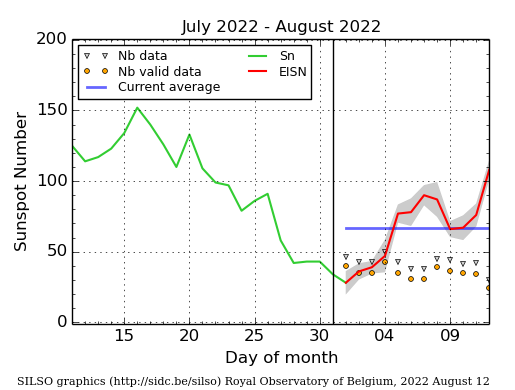
The daily Estimated International Sunspot Number (EISN, red curve with shaded error) derived by a simplified method from real-time data from the worldwide SILSO network. It extends the official Sunspot Number from the full processing of the preceding month (green line), a few days more than one solar rotation. The horizontal blue line shows the current monthly average. The yellow dots give the number of stations that provided valid data. Valid data are used to calculate the EISN. The triangle gives the number of stations providing data. When a triangle and a yellow dot coincide, it means that all the data is used to calculate the EISN of that day.
The SIDC
The Space Weather Briefing presented by the SIDC (https://www.sidc.be) forecaster on duty from July 31 to August 07. It reflects in images and graphs what is written in the Solar and Geomagnetic Activity report: https://www.stce.be/briefings/20220808_SWbriefing.pdf
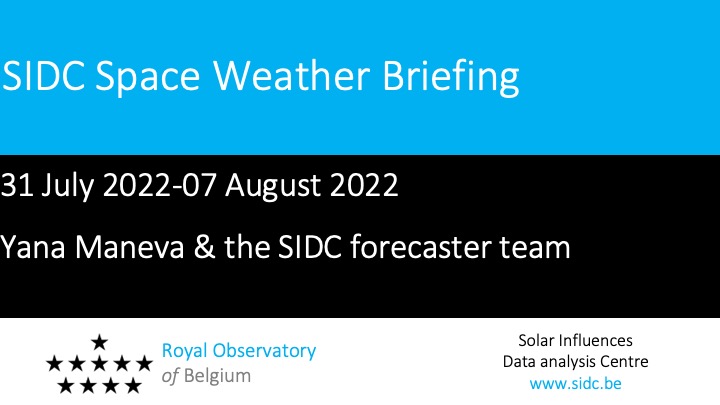
Action!
Check out our activity calendar: activities and encounters with the Sun-Space-Earth system and Space Weather as the main theme. We provide occasions to get submerged in our world through educational, informative and instructive activities.
If you want your event in our calendar, contact us: stce_coordination at stce.be
* August 25, Public Lecture on Space Weather and Aviation, Astropolis, Oostende, Belgium
* September 24-25 Space Pole Open Days, Brussels, Belgium
* October 24-28, 18th European Space Weather Week, Zagreb, Croatia
* November 21-23, Space Weather Introductory Course - onsite, by the STCE, Brussels, Belgium
* December 5, 6, 8, 9, Space Weather Introductory Course - online, by the STCE, zoom
Check: https://www.stce.be/calendar

